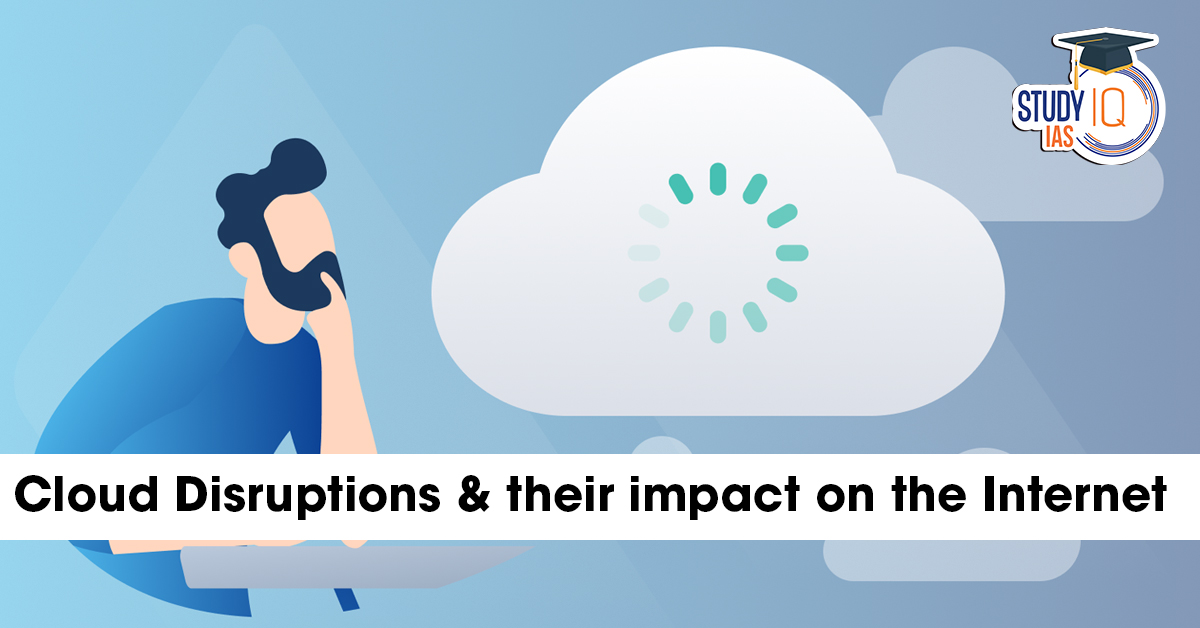Table of Contents
An outage at Amazon Web Services (AWS) – the world’s largest cloud computing provider recently disrupted major portions of the Internet for several hours, affecting over 1,000 global services. The outage underscored the fragility of modern digital infrastructure and the world’s over-dependence on a few tech giants for essential online services.
|
What Caused the AWS Outage? |
|
Why is Concentration of Cloud Services Risky?
- Monopolisation of Internet Infrastructure:
- Three corporations – Amazon (AWS), Microsoft Azure, and Google Cloud control nearly two-thirds of the global cloud computing market.
- This oligopolistic concentration has created “single points of failure” for the Internet.
- Vendor Lock-In and High Exit Barriers: Cloud giants impose high “egress fees” for transferring data between providers, making it costly to switch. This discourages diversification and makes clients locked into a single provider, even when alternatives exist.
- Lack of Transparency and Oversight: These corporations operate with limited regulatory scrutiny, especially concerning data sovereignty, risk management, and disaster preparedness.
- Economic Vulnerability: A 3-6 day outage at one of the top three cloud providers could cause over $15 billion in global economic losses (Lloyd’s Insurance, 2018).
- Cybersecurity and Surveillance Risks: Concentration gives few firms control over sensitive government and citizen data, raising concerns about cyber espionage, data privacy, and surveillance.
|
How Did AWS Become the Internet’s Backbone |
|
Fragility of Cloud Infrastructure
- Interdependency Risks:
- Modern web services rely on multi-layered integrations – databases, APIs, content delivery networks (CDNs), and security layers – all hosted on shared cloud infrastructure.
- A single fault in one component can cascade across multiple dependent systems, as seen in the AWS outage.
- Centralised Data Hubs: Data concentration in a few mega data centres (like AWS’s US-East-1) increases vulnerability to technical failure, natural disasters, or cyberattacks.
- Faulty Software Updates: Even a small bad code deployment can trigger massive disruptions, as seen in the 2024 CrowdStrike–Microsoft incident, which crippled global aviation and banking.
- Lack of Redundancy in Client System: Many businesses depend solely on one provider without multi-cloud failover systems, magnifying the impact of outages.
- Rising Environmental and Energy Costs: Massive data centres consume enormous energy, straining local grids and environmental resources – creating another dimension of vulnerability.
Broader Issues in Cloud Storage and Infrastructure
- Data Sovereignty Concerns: Sensitive data stored in foreign-owned clouds raises national security and privacy issues for countries like India.
- Opaque Service-Level Agreements (SLAs): Cloud providers often limit their liability in contracts, leaving clients to bear losses during outages.
- Cost Inefficiencies and Hidden Charges: Egress fees, bandwidth costs, and storage charges create financial unpredictability for businesses.
- Cybersecurity Vulnerabilities: Centralised clouds are lucrative targets for ransomware, DDoS, or state-sponsored cyberattacks.
- Regulatory Lag: Global regulatory frameworks have not caught up with the cross-border nature of cloud governance.
Way Forward
- Promote Cloud Diversification:
- Encourage multi-cloud and hybrid-cloud strategies among businesses to prevent dependence on a single provider.
- Develop regional cloud ecosystems (e.g., India’s MeghRaj or European Gaia-X) to distribute risks.
- Strengthen Cloud Governance and Transparency:
- Mandate public disclosure of outage reports, security audits, and redundancy measures by cloud providers.
- Introduce a global framework for cloud reliability and accountability, similar to financial stress tests.
- Invest in Edge Computing: Move data processing closer to users – through edge data centres – to reduce latency, increase resilience, and decentralise workloads.
- Ensure Data Sovereignty: Countries should mandate localisation of critical public-sector data and develop national cloud infrastructure for essential services.
- Regulate Market Concentration: Enforce antitrust oversight on Big Tech cloud players to ensure fair competition and prevent monopolistic pricing or bundling.
- Leverage AI and Open-Source Cloud Alternatives: Support AI-driven distributed cloud networks (like Ubicloud, CoreWeave, or Together AI) to build open, modular cloud systems that reduce dependency on a few hyperscalers.


 UNEP Champions of the Earth Award: UN's ...
UNEP Champions of the Earth Award: UN's ...
 Shilp Didi Programme: Empowering Women A...
Shilp Didi Programme: Empowering Women A...
 Is the Falling Rupee a Cause for Alarm?
Is the Falling Rupee a Cause for Alarm?

























